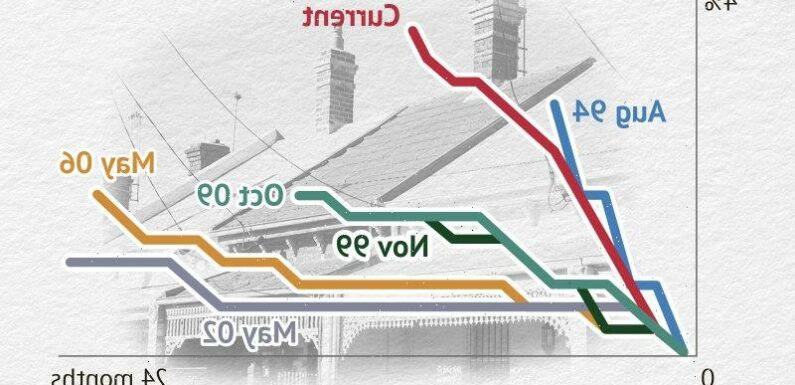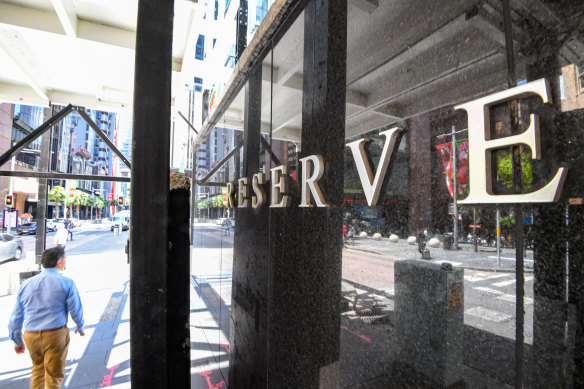
The Reserve Bank has lifted interest rates to an 11-year high of 3.6 per cent and flagged more rises to come as it battles to bring inflation under control.
Following its regular monthly board meeting on Tuesday, the bank added another 0.25 of a percentage point to the official cash rate. It is a record 10th consecutive meeting where the cash rate, which was just 0.1 per cent at the start of May last year, has been increased.
The RBA is expecting economic growth to slow to 1.5 per cent this year and next as interest rates start to drag on consumers.Credit:Peter Rae
The bank is in the midst of its most aggressive tightening of monetary policy since it started targeting the inflation rate in the early 1990s. Inflation reached 7.8 per cent in the final three months of last year, well outside the RBA’s 2 to 3 per cent target band.
On a $604,000 mortgage, Tuesday’s increase will add almost $100 to monthly repayments. On the same mortgage, the cumulative increase in rates has added $1190 to monthly repayments.
In his statement accompanying the decision, RBA governor Philip Lowe made clear that the bank was still some way from halting interest rate rises.
“The board expects that further tightening of monetary policy will be needed to ensure that inflation returns to target and that this period of high inflation is only temporary,” he said.
“In assessing when and how much further interest rates need to increase, the board will be paying close attention to developments in the global economy, trends in household spending and the outlook for inflation and the labour market.
“The board remains resolute in its determination to return inflation to target and will do what is necessary to achieve that.”
Lowe said it appeared inflation had peaked but that price increases for services remained high.
He said rents were growing at their fastest rate “in some years” with vacancy rates across the country.
The overall economy had slowed, with growth likely to be below trend for the next two years.
A key worry for the bank has been a lift in wages growth.
Lowe said while wages were picking up, and the bank remained “alert” to a possible price-wage spiral, the indications at present were positive.
“At the aggregate level, wages growth is still consistent with the inflation target and recent data suggest a lower risk of a cycle in which prices and wages chase one another,” he said.
The RBA is expecting economic growth to slow to 1.5 per cent this year and next as interest rates start to drag on consumers, prompting some fears the economy could suffer a recession over the next 24 months.
Speaking ahead of the bank’s decision at The Australian Financial Review’s Business Summit, Prime Minister Anthony Albanese said he was upbeat about the economic outlook.
Australia was going through a difficult period, dealing with supply chain shortages, the energy transition across the economy, and the impact of Russia’s invasion of Ukraine.
“You can never skate through, and that’s part of my message today. You need to actually be active and on the front foot for growth. I’m optimistic, frankly,” he said.
“So you deal with the immediate crisis, but you set yourself up for the medium and long term.”
Asia-Pacific economist with jobs website Indeed, Callam Pickering, said the decision would not be popular but noted the RBA had little option.
“As painful as higher mortgage rates might be, a persistent period of high inflation will inevitably be more dangerous for jobs and incomes and the overall Australian economy,” he said.
“The market anticipates that the cash rate will peak at around 4.1 per cent this year – implying an additional two 25 basis point hikes.
“For that to occur, we’d need to see inflation show meaningful signs of improvement in April and then July – the next two quarterly inflation releases – along with some softer results from the monthly inflation measure.”
There are signs the bank’s previous rate increases are starting to bite, with data gleaned from Westpac’s retail payment network showing a sharp slowdown through the second half of February.
Westpac senior economist Matthew Hassan said there had been a notable pull-back in spending over recent weeks.
He said once inflation was taken into account, real spending by consumers might be starting to fall.
“While still tentative, the softer tone starting to come out of the card data suggests the anaemic growth in real spending seen late last year may be shifting to outright weakness in early 2023,” he said.
“The detail suggests a slowing in services and non-food retail spending is more than offsetting a lift in food retail and hospitality.”
Hassan said at the state level, activity was weakening most in NSW, Victoria and Queensland. That was despite the two most populous states benefiting from a sharper lift in immigration.
The ANZ-Roy Morgan weekly measure of consumer confidence edged down by 0.1 per cent over the past week to remain deeply in negative territory.
ANZ senior economist Adelaide Timbrell said confidence among all consumer groups remained extremely low.
“It was the fourth consecutive week with confidence among the worst 12 results since the COVID outbreak in Australia,” she said.
Cut through the noise of federal politics with news, views and expert analysis from Jacqueline Maley. Subscribers can sign up to our weekly Inside Politics newsletter here.
Most Viewed in Politics
From our partners
Source: Read Full Article
